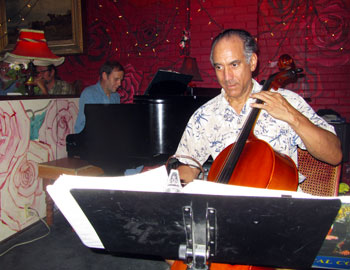Chris Filley, MD
Neurology and the Magic of Music
By Jenny Deam Every few weeks Chris Filley, MD, trades his suit and reflex hammer for jeans and a tip jar, playing piano for the Sunday brunch crowd under a canopy of twinkling lights at a hip Denver eatery.
Every few weeks Chris Filley, MD, trades his suit and reflex hammer for jeans and a tip jar, playing piano for the Sunday brunch crowd under a canopy of twinkling lights at a hip Denver eatery.
Playing a set that skips centuries seamlessly, bopping from Bach to the Beatles before moseying on to Miles Davis, few know that
Filley is a practitioner of behavioral neurology.
“Music is a product of the brain just like any other behavior,” he says.
An intricate dance of sight and sound meeting motor skills, making music is a tangle of movement controlled by the brain. But, for Filley, there’s far more to know about how the brain is organized to produce those sounds.
Classical music, with its strict, predictable sequences engages the dorsolateral prefrontal cortex of the brain, which controls planning, organizing and regulating. Jazz, with its riffing and improvising, relies more on the medial frontal cortex responsible for functions such as stimulus-independent thought and spontaneity.
“With Beethoven, you play what the score directs you to play,” Filley says. “But with
Filley, professor of neurology and psychiatry at the University of Colorado School of Medicine and director of the behavioral neurology section, has dedicated his
Filley says his father, Giles Filley, MD, a School of Medicine pulmonologist and
Filley was 8 years old when he began playing clarinet. In 1964, when he was 13, the Beatles rocked his world. With his older brother Josh, he plunked down $6 to see the band at Red Rocks.
“We were totally hooked,” Filley remembers. He soon swapped clarinet for guitar, later adding piano to his repertoire.
In the early 1970s, while at Williams College in Massachusetts, he played in a band.
Those were heady times for Filley and the nation. He considered becoming a journalist, a teacher, a musician. But his father’s influence echoed; he chose medicine, figuring he could help more people in that profession
As a second-year medical student, Benzi Kluger, MD, looked to Filley as a mentor and for inspiration. He found a kindred spirit also
“He would tell me to think broadly and live broadly,” says Kluger, who plays rock guitar and bass
Like medicine, music has logic, Filley says. And like music, medicine can encourage creativity.
“Either one is great by itself,” he says, “but together they are all the more fascinating.”